Linhui Dai
A Gated Cross-domain Collaborative Network for Underwater Object Detection
Jun 25, 2023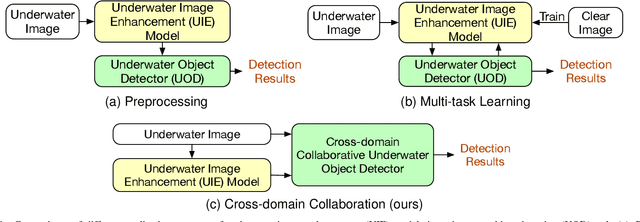

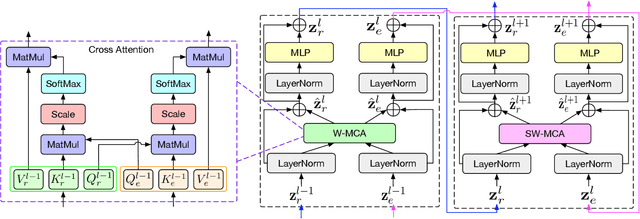
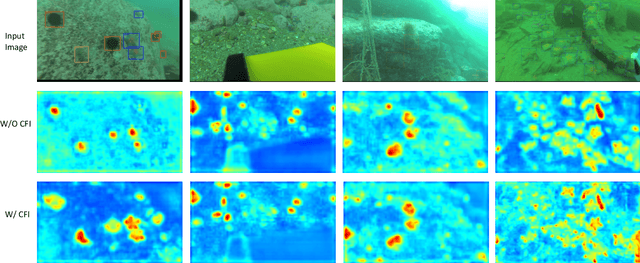
Abstract:Underwater object detection (UOD) plays a significant role in aquaculture and marine environmental protection. Considering the challenges posed by low contrast and low-light conditions in underwater environments, several underwater image enhancement (UIE) methods have been proposed to improve the quality of underwater images. However, only using the enhanced images does not improve the performance of UOD, since it may unavoidably remove or alter critical patterns and details of underwater objects. In contrast, we believe that exploring the complementary information from the two domains is beneficial for UOD. The raw image preserves the natural characteristics of the scene and texture information of the objects, while the enhanced image improves the visibility of underwater objects. Based on this perspective, we propose a Gated Cross-domain Collaborative Network (GCC-Net) to address the challenges of poor visibility and low contrast in underwater environments, which comprises three dedicated components. Firstly, a real-time UIE method is employed to generate enhanced images, which can improve the visibility of objects in low-contrast areas. Secondly, a cross-domain feature interaction module is introduced to facilitate the interaction and mine complementary information between raw and enhanced image features. Thirdly, to prevent the contamination of unreliable generated results, a gated feature fusion module is proposed to adaptively control the fusion ratio of cross-domain information. Our method presents a new UOD paradigm from the perspective of cross-domain information interaction and fusion. Experimental results demonstrate that the proposed GCC-Net achieves state-of-the-art performance on four underwater datasets.
Edge-guided Representation Learning for Underwater Object Detection
Jun 01, 2023



Abstract:Underwater object detection (UOD) is crucial for marine economic development, environmental protection, and the planet's sustainable development. The main challenges of this task arise from low-contrast, small objects, and mimicry of aquatic organisms. The key to addressing these challenges is to focus the model on obtaining more discriminative information. We observe that the edges of underwater objects are highly unique and can be distinguished from low-contrast or mimicry environments based on their edges. Motivated by this observation, we propose an Edge-guided Representation Learning Network, termed ERL-Net, that aims to achieve discriminative representation learning and aggregation under the guidance of edge cues. Firstly, we introduce an edge-guided attention module to model the explicit boundary information, which generates more discriminative features. Secondly, a feature aggregation module is proposed to aggregate the multi-scale discriminative features by regrouping them into three levels, effectively aggregating global and local information for locating and recognizing underwater objects. Finally, we propose a wide and asymmetric receptive field block to enable features to have a wider receptive field, allowing the model to focus on more small object information. Comprehensive experiments on three challenging underwater datasets show that our method achieves superior performance on the UOD task.
Boosting R-CNN: Reweighting R-CNN Samples by RPN's Error for Underwater Object Detection
Jun 28, 2022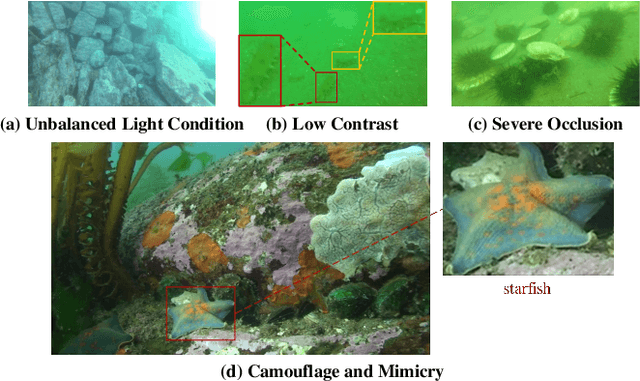
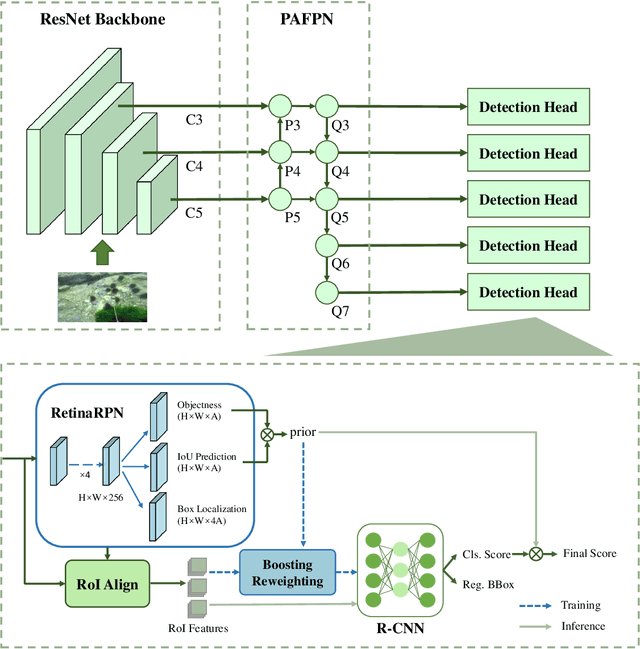
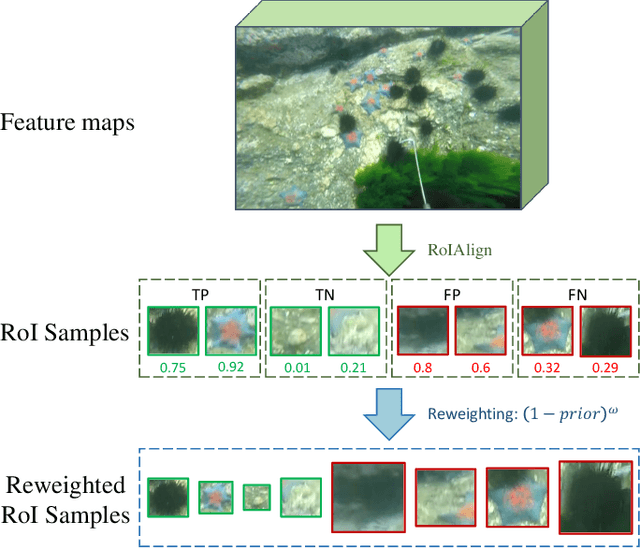
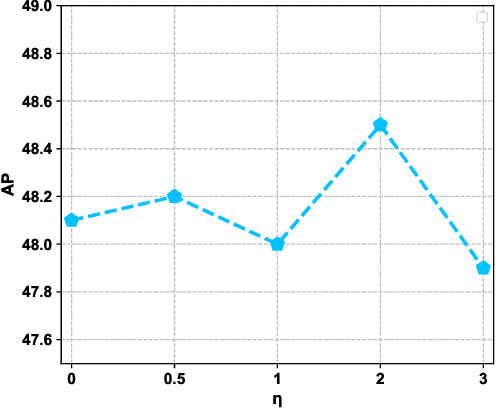
Abstract:Complicated underwater environments bring new challenges to object detection, such as unbalanced light conditions, low contrast, occlusion, and mimicry of aquatic organisms. Under these circumstances, the objects captured by the underwater camera will become vague, and the generic detectors often fail on these vague objects. This work aims to solve the problem from two perspectives: uncertainty modeling and hard example mining. We propose a two-stage underwater detector named boosting R-CNN, which comprises three key components. First, a new region proposal network named RetinaRPN is proposed, which provides high-quality proposals and considers objectness and IoU prediction for uncertainty to model the object prior probability. Second, the probabilistic inference pipeline is introduced to combine the first-stage prior uncertainty and the second-stage classification score to model the final detection score. Finally, we propose a new hard example mining method named boosting reweighting. Specifically, when the region proposal network miscalculates the object prior probability for a sample, boosting reweighting will increase the classification loss of the sample in the R-CNN head during training, while reducing the loss of easy samples with accurately estimated priors. Thus, a robust detection head in the second stage can be obtained. During the inference stage, the R-CNN has the capability to rectify the error of the first stage to improve the performance. Comprehensive experiments on two underwater datasets and two generic object detection datasets demonstrate the effectiveness and robustness of our method.
AO2-DETR: Arbitrary-Oriented Object Detection Transformer
May 25, 2022
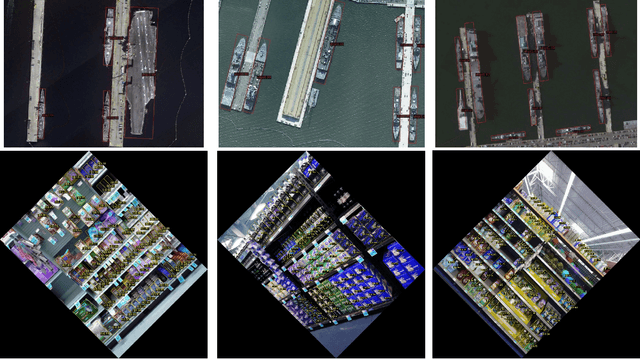

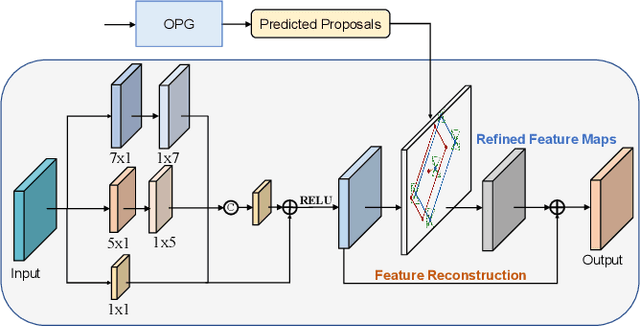
Abstract:Arbitrary-oriented object detection (AOOD) is a challenging task to detect objects in the wild with arbitrary orientations and cluttered arrangements. Existing approaches are mainly based on anchor-based boxes or dense points, which rely on complicated hand-designed processing steps and inductive bias, such as anchor generation, transformation, and non-maximum suppression reasoning. Recently, the emerging transformer-based approaches view object detection as a direct set prediction problem that effectively removes the need for hand-designed components and inductive biases. In this paper, we propose an Arbitrary-Oriented Object DEtection TRansformer framework, termed AO2-DETR, which comprises three dedicated components. More precisely, an oriented proposal generation mechanism is proposed to explicitly generate oriented proposals, which provides better positional priors for pooling features to modulate the cross-attention in the transformer decoder. An adaptive oriented proposal refinement module is introduced to extract rotation-invariant region features and eliminate the misalignment between region features and objects. And a rotation-aware set matching loss is used to ensure the one-to-one matching process for direct set prediction without duplicate predictions. Our method considerably simplifies the overall pipeline and presents a new AOOD paradigm. Comprehensive experiments on several challenging datasets show that our method achieves superior performance on the AOOD task.
Achieving Domain Generalization in Underwater Object Detection by Image Stylization and Domain Mixup
Apr 06, 2021



Abstract:The performance of existing underwater object detection methods degrades seriously when facing domain shift problem caused by complicated underwater environments. Due to the limitation of the number of domains in the dataset, deep detectors easily just memorize a few seen domain, which leads to low generalization ability. Ulteriorly, it can be inferred that the detector trained on as many domains as possible is domain-invariant. Based on this viewpoint, we propose a domain generalization method from the aspect of data augmentation. First, the style transfer model transforms images from one source domain to another, enriching the domain diversity of the training data. Second, interpolating different domains on feature level, new domains can be sampled on the domain manifold. With our method, detectors will be robust to domain shift. Comprehensive experiments on S-UODAC2020 datasets demonstrate that the proposed method is able to learn domain-invariant representations, and outperforms other domain generalization methods. The source code is available at https://github.com/mousecpn.
Towards a Unified Approach to Single Image Deraining and Dehazing
Mar 26, 2021



Abstract:We develop a new physical model for the rain effect and show that the well-known atmosphere scattering model (ASM) for the haze effect naturally emerges as its homogeneous continuous limit. Via depth-aware fusion of multi-layer rain streaks according to the camera imaging mechanism, the new model can better capture the sophisticated non-deterministic degradation patterns commonly seen in real rainy images. We also propose a Densely Scale-Connected Attentive Network (DSCAN) that is suitable for both deraining and dehazing tasks. Our design alleviates the bottleneck issue existent in conventional multi-scale networks and enables more effective information exchange and aggregation. Extensive experimental results demonstrate that the proposed DSCAN is able to deliver superior derained/dehazed results on both synthetic and real images as compared to the state-of-the-art. Moreover, it is shown that for our DSCAN, the synthetic dataset built using the new physical model yields better generalization performance on real images in comparison with the existing datasets based on over-simplified models.
Learning for Unconstrained Space-Time Video Super-Resolution
Feb 25, 2021



Abstract:Recent years have seen considerable research activities devoted to video enhancement that simultaneously increases temporal frame rate and spatial resolution. However, the existing methods either fail to explore the intrinsic relationship between temporal and spatial information or lack flexibility in the choice of final temporal/spatial resolution. In this work, we propose an unconstrained space-time video super-resolution network, which can effectively exploit space-time correlation to boost performance. Moreover, it has complete freedom in adjusting the temporal frame rate and spatial resolution through the use of the optical flow technique and a generalized pixelshuffle operation. Our extensive experiments demonstrate that the proposed method not only outperforms the state-of-the-art, but also requires far fewer parameters and less running time.
AIM 2020 Challenge on Learned Image Signal Processing Pipeline
Nov 10, 2020

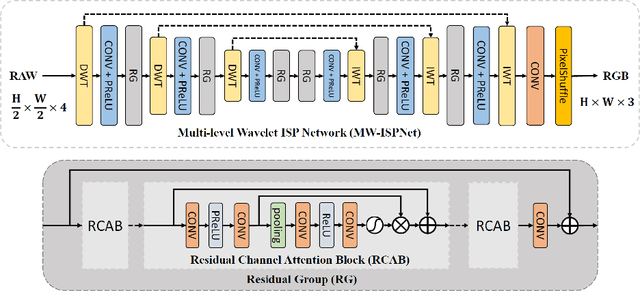
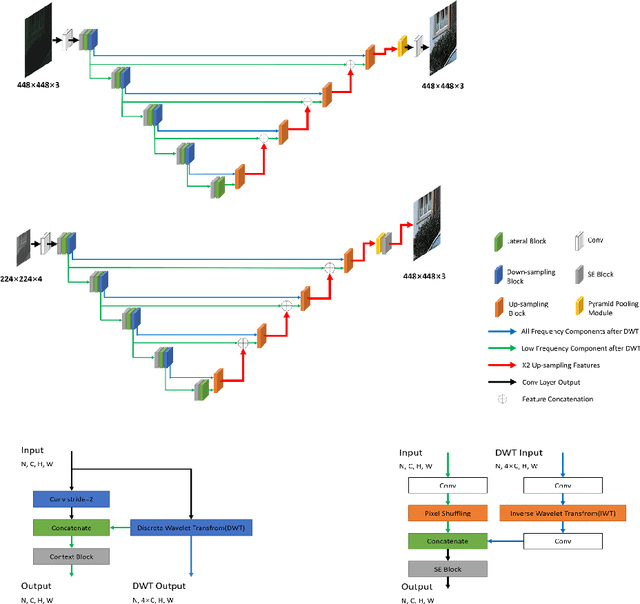
Abstract:This paper reviews the second AIM learned ISP challenge and provides the description of the proposed solutions and results. The participating teams were solving a real-world RAW-to-RGB mapping problem, where to goal was to map the original low-quality RAW images captured by the Huawei P20 device to the same photos obtained with the Canon 5D DSLR camera. The considered task embraced a number of complex computer vision subtasks, such as image demosaicing, denoising, white balancing, color and contrast correction, demoireing, etc. The target metric used in this challenge combined fidelity scores (PSNR and SSIM) with solutions' perceptual results measured in a user study. The proposed solutions significantly improved the baseline results, defining the state-of-the-art for practical image signal processing pipeline modeling.
AWNet: Attentive Wavelet Network for Image ISP
Sep 13, 2020



Abstract:As the revolutionary improvement being made on the performance of smartphones over the last decade, mobile photography becomes one of the most common practices among the majority of smartphone users. However, due to the limited size of camera sensors on phone, the photographed image is still visually distinct to the one taken by the digital single-lens reflex (DSLR) camera. To narrow this performance gap, one is to redesign the camera image signal processor (ISP) to improve the image quality. Owing to the rapid rise of deep learning, recent works resort to the deep convolutional neural network (CNN) to develop a sophisticated data-driven ISP that directly maps the phone-captured image to the DSLR-captured one. In this paper, we introduce a novel network that utilizes the attention mechanism and wavelet transform, dubbed AWNet, to tackle this learnable image ISP problem. By adding the wavelet transform, our proposed method enables us to restore favorable image details from RAW information and achieve a larger receptive field while remaining high efficiency in terms of computational cost. The global context block is adopted in our method to learn the non-local color mapping for the generation of appealing RGB images. More importantly, this block alleviates the influence of image misalignment occurred on the provided dataset. Experimental results indicate the advances of our design in both qualitative and quantitative measurements. The code is available publically.
Video Interpolation via Generalized Deformable Convolution
Aug 24, 2020



Abstract:Video interpolation aims at increasing the frame rate of a given video by synthesizing intermediate frames. The existing video interpolation methods can be roughly divided into two categories: flow-based methods and kernel-based methods. The performance of flow-based methods is often jeopardized by the inaccuracy of flow map estimation due to oversimplified motion models while that of kernel-based methods tends to be constrained by the rigidity of kernel shape. To address these performance-limiting issues, a novel mechanism named generalized deformable convolution is proposed, which can effectively learn motion information in a data-driven manner and freely select sampling points in space-time. We further develop a new video interpolation method based on this mechanism. Our extensive experiments demonstrate that the new method performs favorably against the state-of-the-art, especially when dealing with complex motions.
 Add to Chrome
Add to Chrome Add to Firefox
Add to Firefox Add to Edge
Add to Edge